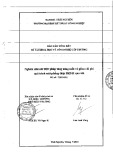
Effect
of
a
feedback
control
by
early
secondary
xylem
formation
on
the
outcome
of
competition
between
leafy
shoots
in
apple
(Malus
x
domestica
Borkh.)
A. Jebari
J.
Crabbé
Morphogen6se
V6g6tate
Appliqu6e,
Facult6
des
Sciences
Agronomiques,
Gembloux,
Belgique
Introduction
From
bud
break
onwards,
a
developing
shoot
induces,
within
its
bearing
stem,
a
strand
of
secondary
xylem,
which
progres-
sively
expands
basipetally
along
the
stem
and
spreads
tangentially
around
it.
The
rate
of
this
process
and
the
differentiated
wood
characteristics,
e.g.,
frequency
and
width
of
vessels,
depend
upon
the
rate
of
shoot
elongation
(Jebari
and
Crabbe,
in
preparation).
The
varying
conducting
ca-
pacity
resulting
from
these
early
events
affects
the
outcome
of
shoot
competition
and
plays
a
part
in
the
complex
control
of
the
apical
dominance
syndrome,
in
woody
plants.
Materials
and
Methods
On
1
yr
old
apple
trees,
cv.
MM
106,
the
unique
axis
was
pruned
at
ca
60
cm
high
before
bud
burst
and
debudded
except
for
the
2
uppermost
buds
(designated
as
buds/shoots
1
and
2,
1
being
the
most
distal)
and,
when
stated,
bud
4
or
5,
located
on
orthostichies
next
to
bud
1
or
2,
respectively.
All
shoots
present
were
periodically
mea-
sured.
The
degree
of
dominance
between
the
2
upper
shoots
is
evaluated
by
the
ratio
of
their
lengths
(L
1
/L
2
).
Furthermore,
anatomical
inves-
tigation
was
carried
out
in
order
to
evaluate
initiation
and
expansion
of
cambial
activity,
new
secondary
xylem
characteristics
and
their
varia-
tions.
The
experiment
was
limited
to
the
spring
growth
flush,
i.e.,
from
bud
break
to
late
June.
Results
On
a
pruned
woody
axis,
the
outcome
of
competition
between
the
2
uppermost
shoots
is
very
uncertain.
When
a
large
population
of
plants
is
pruned
as
stated
above,
a
continuum
is
generally
observed
between
2
extreme
habits:
strong
domi-
nance
of
shoot
1
on
one
side
and
forking
due
to
subequal
elongation
of
both
shoots
on
the
other.
In
fact,
in
most
plants,
shoot
1
has,
owing
to
its
distal
position,
a
precedency
(acrotony)
which
makes
it
start
growing
first -
or,
at
least,
make
up
some
initial
retardation
and
overtake
shoot
2 -
and
then
amplify
its
advance
during
the
re-
maining
season.
However,
when
shoot
1
is
very
delayed,
a
fork
arises
because
shoot
2
is
only
able
to
maintain
its
small

initial
advance
and
cannot
amplify
it
by
growing
faster
than
shoot
1.
The
latter
case
is
far
from
uncommon:
it
may
amount
to
40%
of
the
total
population,
depending
upon
cultural
conditions
and
treatments
(see
below).
Fig.
1
shows
these
extremes
in
shoot
elongation
behavior
in
selected
subpopulations.

Among
the
conditions
favoring
either
extreme
behavior,
we
could
mention
the
presence
of
a
third
shoot.
For
example,
bud
4
which
is
next
to
bud
1’s
orthostichy
increases
the
probability
of
strong
domi-
nance
of
this
latter;
whereas
bud
5
near
bud
2
favors
the
occurrence
of
a
fork
(Jebari
and
Crabbe,
1984;
Crabbe,
1985).
This
is,
however,
further
complicated
by
the
frequent
helical
deviation
of
the
basi-
petal
progression
of
the
secondary
xylem
strands,
which
proceed
seemingly
at
ran-
dom
clock-
or
counterclockwise.
The
out-
come
of
competition
between
the
2
upper-
most
shoots
consequently
results
alto-
gether
from
which
one
sets
growth
on
first,
from
the
presence
of
a
third
bud
and
from
the
direction
of
this
deviation.
Fig.
2
dis-
plays
the
distribution
of
the
degrees
of
dominance
in
selected
subpopulations
where
deviation
infringes
upon
the
small
angle
between
1
and
2
(top)
or
on
the
larger
one
(bottom)
and
where
bud
1
is
fa-
vored
by
the
presence
of
bud
4
(left)
or
bud
2
by
that
of
bud
5
(right).
Anatomical
investigation
gives
a
pos-
sible
interpretation
of
these
rather
sur-
prising
results.
In
a
large
population
of
plants
differently
treated,
5
groups
were
selected
according
to
the
time
at
which
shoot
1
overtakes
shoot
2
or
to
mean
final
degree
of
dominance.
The
last
of
these
groups
comprises
the
forked
plants.
Considering
the
relative
elongations
of
both
shoots
together
with
the
relative
width
of
new
xylem
formed
below
the
shoots
in
the
bearing
axis,
it
clearly
appears
(Fig.
3)
that,
in
the
last
group,

shoot
2
invests
relatively
more
matter
in
wood
formation
per
unit
shoot
length
than
shoot
1.
The
resulting
increase
in
con-
ducting
capacity
explains
why
shoot
2
successfully
opposes
and
stays
abreast
of
its
competitor.
Discussion
and
Conclusion
The
control
of
secondary
xylem
differentia-
tion
by
shoot
growth
in
the
bearing
stem
below
is
not
easy
to
explain.
It
differs
markedly
according
to
the
complex
domi-
nance
relations
of
the
shoots:
extreme
habits,
like
strong
dominance
of
the
distal
shoot
or
forking,
proceed
from
different
modes
of
regulation.
In
the
competition
among
shoots,
the
‘classical’
hormone-directed
nutrient
diver-
sion
cannot
be
discarded
as
part
of
the
explanation.
However,
cambial
activity
also
interferes
by
long-term
effects
through
variation
in
the
conducting
capaci-
ty
of
the
main
stem.
References
Crabbe
J.
(1985)
Aspects
of
the
apical
control
on
branching
in
one-year-old
caulinary
axes
of
woody
plants.
Acta
Univ.
Agric.
Brno
33,
555-
560
Crabbe
J.
(1986)
Hi6rarchie
et
opportunisme
dans
le
développement
de
I’appareil
caulinaire
des
arbres.
Nat.
Monspel.
Ser.
Bot.
suppl.
339-
350
Jebari
A.
&
Crabbe
J.
(1984)
Aspects
of
the
interaction
between
the
two
upper
shoots
left
on
a
pruned
one-year-old
axis
in
apple.
4th
Congr.
Eur.
Fed. Soc.
Plant
Physiol.,
book
of
Abstr.
244-245






![Báo cáo seminar chuyên ngành Công nghệ hóa học và thực phẩm [Mới nhất]](https://cdn.tailieu.vn/images/document/thumbnail/2025/20250711/hienkelvinzoi@gmail.com/135x160/47051752458701.jpg)









